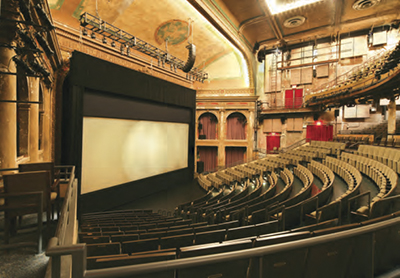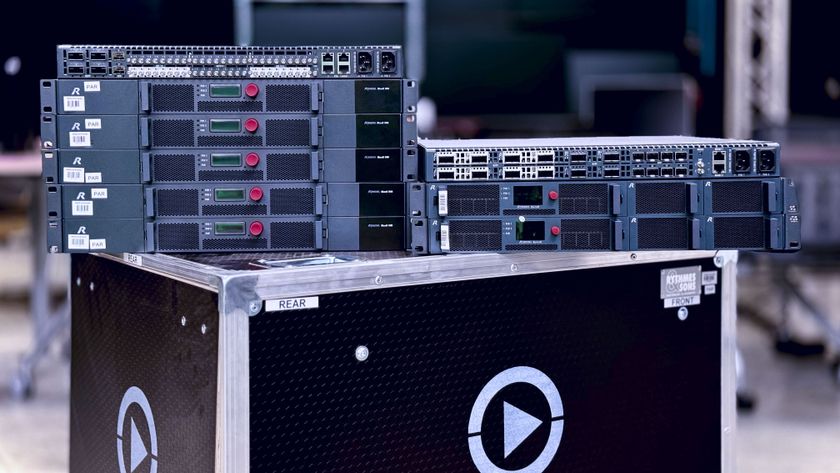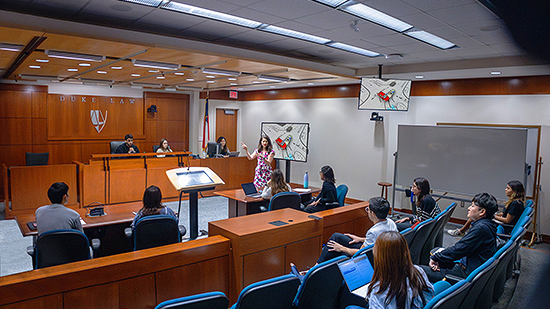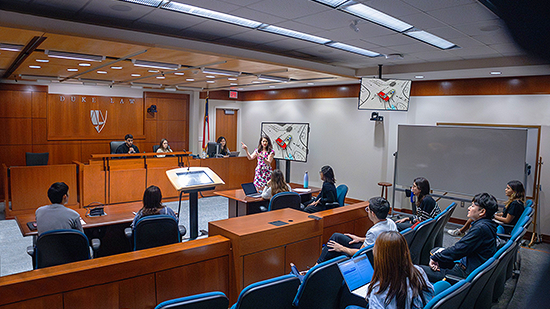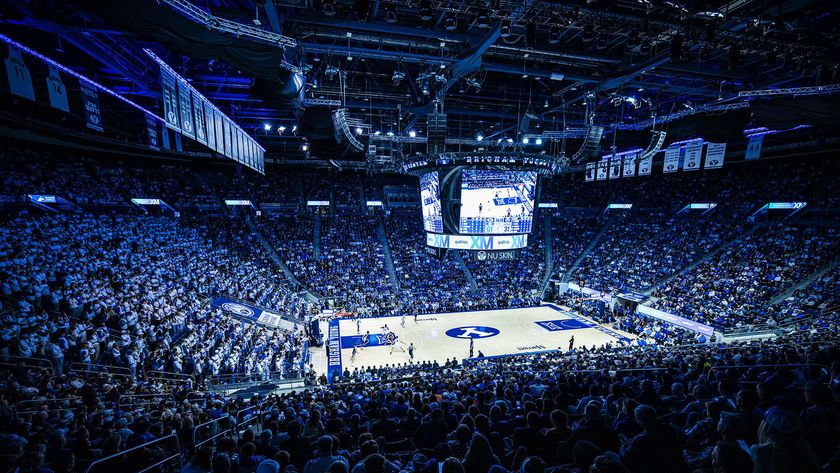You’ve Got the Tools. Can You Make the Trade?
The Brooklyn Academy of Music’s new Steinberg Screen at the Harvey Theater, manufactured by Stewart Filmscreen, is
one of the largest in Brooklyn.Cruise ships, mini cinemas, oilrigs, and— wait for it—fish ladders. Is there any place AV integration fears to tread?
Specialty integration may be the road not yet taken for many integrators, but with revitalized downtowns sprouting performing arts venues with boutique cinemas, and entertainment options galore on the high seas, it may provide a new opportunity for AV integrators willing to take on the challenges these singular projects require.
Impact installations that serve a smaller, more focused number of viewers are certainly on the rise. “For simplicity’s sake, you can sort these venues into two general types: multipurpose venues that change based on whether the purpose is to entertain or educate, and dedicated performing arts/boutique cinemas housed in historic buildings that have been upgraded to today’s AV standards,” said Michael Bridwell, director of marketing for Digital Projection, Inc.
The rise in venues includes those that from the outset were specified and upgraded to suit multiple uses. Often, this means catering to very different audiences as well.
“In these projects the AV components are selected because they perform well in a variety of conditions,” Bridwell explained. “An example is the West Hollywood Library, which, with Waveguide Consulting’s help, fills various roles with the same AV system: as a host venue for city council meetings and public forums, as a community space for education opportunities, and as a screening venue for film festivals. In order to operate in varying amounts of ambient light, Waveguide enlisted high-brightness TIT AN projectors that can deliver imagery regardless of the lighting conditions.”
At The Picture Show
The marketplace consists of all types of theatre owners; those operating the largest movie complexes down to independent local exhibitors, noted Scott Freidberg, vice president of north American digital cinema sales for Barco. “All of them are trying to cater to the particular tastes of their patron base. But as cinema has evolved into a more sensory experience, complete with bigger sound and striking images, the boutique or niche markets also have to define what they bring to their communities. Barco can create a solution from the smallest to the biggest cinema houses and everything in between.”
Many boutique cinemas are situated in restored historic structures where an advanced AV upgrade occurred during the renovation. One is the New Orleans’ Joy Theater, circa 1940. The Joy is a prime example of Hollywood’s golden age of cinema.
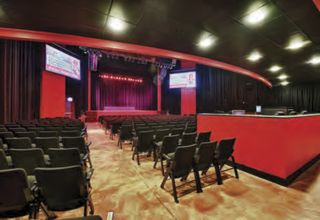
New Orleans’ Joy Theater received a full renovation, including brand-new Digital Projection TITAN projectors and a JBL cinema series audio upgrade.“In 2011, the theater received a full renovation, including brand-new TIT AN projectors and a JBL cinema series audio upgrade, to catapult the venue back into the limelight as a live performance venue as well as a boutique movie cinema,” Bridwell said. “These venues and many venues like them share a common thread: they depend primarily on the patronage of the local community to keep them alive. Each venue has invested in advanced AV components to ensure attendees receive a top-tier experience, regardless of the theme or purpose of the presentation.”
Art house cinemas and community-driven performing arts venues are looking to deliver compelling entertainment via pragmatically chosen, long-life AV components that will serve the community for years to come, he explained. The Santa Clarita Performing Arts Center, for example, is a regionally funded venue, custom-built to amply serve the entertainment and educational tastes of the area.
“With a powerfully diverse array of theater and musical productions, the venue enlists immersive projection to create digital sets and backdrops without the fabrication costs of building full sets for each performance,” Bridwell added.
This specialized cinema market comes with a set of unique requirements, Freidberg said. “Hollywood content requires projector manufacturers to meet presentation standards as well as safeguarding the content passing through it. We have to employ a projector built to fulfill those studio’s and director’s requirements, and to present their finished product in both a vibrant and secure environment.”
Barco’s DP2K-10Sx, for example, can illuminate smaller screens at the right firepower and the right cost, he added. “We offer the most efficient line-up of projectors so our clients pay for only what they need. And we’re furthering the efficiency factor by bundling functions such as servers/playback into the core projector, where they have traditionally been external. There’s more bang for the buck.”
Barco requires its cinema integrators to go through specialized training, “They’re tested to ensure that they are representing our products and our company in a consistent and predictable manner,” Freidberg said. “We rely on our cinema integrators to be just as good as we are.”
The success of any business hinges on knowing your clientele, he said. “Barco does well because frankly we understand the cinema industry. Cinema is not a nine-to-five business; we know what is important to each cinema operator. And we know the worst thing for an operator is to miss a show because of a technical problem.”
Cruise Control
Before dipping a toe into the waters of the cruise ship industry, it would be helpful to understand the machinations of this segment of specialty AV integration. Perhaps no one knows it with more depth than Marc Goossens, business development manager of installation markets for Meyer Sound.
Prior to joining Meyer Sound, Goossens was senior vice president of FUNA International, which specializes in the design, integration, and project management of large-scale and highly complex AV systems. With a maritime-focused background, he also worked as an electronics officer for Holland America Cruise Line before joining a Florida AV company that was very active in the cruise industry.
Cruise ship growth used to be high, Goossens noted, but with the economic downturn, construction of new ships has decreased.
“On the upside,” he said, “the cruise lines are putting more emphasis on unique entertainment, so the volume of spending tends to be a bit higher than before. Twenty years ago, cruise ship theatre systems consisted of minimal speakers systems and very limited overall capability; now they resemble more of a Las Vegas-style entertainment venue where everything is top quality.”
This creates another potential challenge for integrators in the cruise market—installation of wireless mic systems. “Wireless mic deployment on cruise ships can be challenging when using large quantities of mics because ships are made of steel, which creates a unique environment,” Goossens said. “As an integrator, you have to operate at a slightly higher technical level than the average integrator.”
A lesser-known marine niche is that of super or mega yachts. Some of these owners spend as much as a small cruise liner on full commercial integrated systems, Goossens explained. “However, unlike commercial cruise lines, owners of private yachts are flexible with installations schedules and typically have healthy budgets.”
Meyer Sound loudspeakers for this market include the smaller, low-voltage loudspeakers, with the aim being to get the most power from a smaller speaker. “This is a small world in which an integrator would have to be known or know someone involved; it’s largely word-of- mouth,” he added.
New ship builds are far and few between, agreed Robert Foster, director of sales for the broadcast division at Marshall Electronics. “But there are still opportunities, and the flow of new technology brings still other opportunities for integrators, especially with IP cameras and some small HDMI cameras.”
Marshall has provided IP cameras for oilrigs, pipelines, and even fish ladders in the Pacific Northwest where cameras count and record the movements of salmon in high-def.
“We’ve been involved with many cruise ship AV projects around the world,” Foster said, “featuring video rack systems in shipboard entertainment venues and broadcast centers. Many of our video rack units fit these installations because the units offer a lot of configurations including duals, triples, and quads. The rack units are available with different video input options that allow you the ability to monitor different video signals such as composite or high definition video as well as VGA or a DVI signal for your data.”
Systems integrators might consider taking advantage of innovative applications both inside the ship and on deck. “Something as simple as the shipboard Wi-Fi system can be used to have IP-based cameras mounted on masts and various places on deck to provide views of swimming pools or the ocean,” said Russ Walker, director of strategic planning and business development at Marshall. “Pan and tilt cameras can be steered to look at islands.”
The crew could allow passengers take control of the cameras to get views of passing ships, etc., he added. “Cruise ship lines are looking for ways to add to the passenger experience and we offer that through our IP cameras. They may want pan and tilt for use in nightclubs for image magnification, or to pan the dance floors.”
This camera technology, once costing tens of thousands of dollars, is, in many cases, at a fraction of that cost, opening the door of opportunity for cutting-edge imaging shipboard. “Now, this is an affordable value proposition,” Walker said.
Nils Quak, public relations manager for Riedel Communications, which recently announced an expansion of its cruise ship sales force, noted that usually systems in cruise ships, as well as theaters and performing arts centers, are isolated, discreet systems. “Integrating all signals into one single infrastructure, as we do with our fiber-based backbone system MediorNet, helps tremendously in streamlining the entire installation and allows for significant savings in costs in regards to cabling, installation, weight, and maintenance,” he said. “MediorNet is a scalable, real-time network that transports HD video, audio, communications, and data in a multipoint network. This means any signal can be sent to any, or even multiple, outputs. MediorNet’s routing capabilities allow for quick and flexible routing changes.”
Weather Or Not
The cruise itinerary may be planned in advance, but weather is not.
For Princess Cruises, one of several cruise clients, Meyer Sound developed the Ultra- Weather Protection option for certain speakers being specified for use outside on an open deck. The MILO high-power curvilinear array loudspeaker is one such speaker and is featured on the line’s Caribbean Princess, as well as several other ships operated by Princess Cruises.
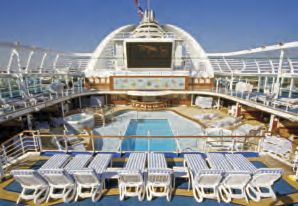
A Meyer Sound MICA line array loudspeaker system was installed in Princess Cruises’ Ruby Princess to deliver highly intelligible audio and thrilling sound effects and music at
a substantial distance while firing into strong headwinds. Meyer Sound’s UltraWeatherized protection feature ensures that the system operates reliably even in the extremely harsh weather conditions at sea.“In addition to the cruise ship market, there has also been interest in the UltraWeather Protection option from other industries, such as theme parks, which can have very similar exposure to sun and an ocean salt environment that cruise ships have,” Goossens said.
Catering to the environmental challenges encountered on all-year-round cruise ships such as salt, air, high winds, and storms, has helped make the products of One Systems better for every direct weather application, said sales and marketing manager Mike Torlone. “Every product we make is weatherproof, and because they deliver a unique combination of excellent sound quality and intelligibility, plus direct-weather capability, they address a range of unique applications.”
Like other customers, cruise ship clients want to be immersed in high-quality sound everywhere, and Torlone said One Systems speakers and suspension accessories make it possible for its partners to meet a wide range of needs for high quality sound for outdoor and for indoor applications as well.
“These specialty applications offer consultants and contractors huge opportunities to create new customers,” he noted. “One Systems speakers are used by a number of leading cruise ship lines all over the world. What ship owners like and appreciate is the sound quality and intelligibility they deliver, the installation flexibility the range offers, and the fact that it offers a broad range of speaker models and suspension kits built with 316-grade marine stainless steel that is a prerequisite for use on ocean-going vessels.”
Going Swimmingly
Another specialty segment being addressed by One Systems is for natatoriums, indoor swimming pools where the environmental challenges are entirely different than in direct weather applications.
“In natatoriums, the combination of air, chlorine, and human byproducts creates chloramines, which get deposited on all surfaces,” Torlone said. “Chloramines cause stress-corrosion cracking, which attacks speaker rigging and support materials on a molecular level, thereby shortening product life and creating a safety hazard, too.”
One Systems natatorium speakers use grilles and hardware made of AL-6XN, a super austenitic alloy that contains six-percent molybdenum, which is immune to stress-corrosion cracking and ensures long useful life without the need for ongoing safety inspections.
“Our models have the intelligibility and pattern control necessary to ensure that they’ll deliver outstanding coverage in the highly reverberant acoustical environment of an indoor pool,” he said.
The Bottom Line
Cruise ship AV installations come with unique challenges, more so than with land-based projects, Goossens advised. “For example, there are very real limitations on space, weight, heat-load, and power-consumption on ships.”
Two factors are immoveable in the cruise ship installation market: budget and delivery date, he added. “Cruise lines commonly start selling their cruises a year ahead of the actual ship’s delivery. Their build contracts come with penalties, costing the shipyards millions if they are late. That makes project scheduling and management a very daunting task.”
Karen Mitchell is a freelance writer living in Boulder, CO.
A Theater Grows in Brooklyn
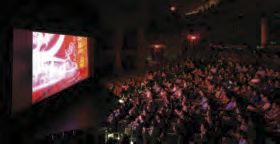
Designed for live music, drama, and dance, the Harvey Theater was renovated in order
to bring high-quality cinematic presentations, including first-run 2D and 3D films on a single screen to audiences. When the screen is stored and the room is put back to its live performance mode, there is no obvious indication that the room has a cinema component at all.There’s nothing diminutive about the 831-seat cinema venue, known as the Steinberg Screen at the BAM Harvey Theater, but it’s a special spot.
Opened in 1904, the venue went through various incarnations, including a period when it was shuttered, before its major renovation in 1987. Designed for live music, drama, and dance, a very recent technical revision was needed in order to accommodate BAM’s desire to bring high-quality cinematic presentations, including first-run 2D and 3D films on a single screen to its audiences.
Enter Auerbach Pollock Friedlander, working with BAM and Mitchell/Giurgola Architects to realize BAM’s vision by providing theatre and audio/video consulting for digital cinema projection and also for new seating.
The installation involved a great deal of custom design and coordination by APF senior associate and AV project manager Daniel Mei, with rigging design and theatre consulting project management by APF senior associate Don Guyton and principal in charge Steven Friedlander.
“This is a unique venue,” said Paul Garrity, principal at Auerbach Pollock Friedlander. “It’s not a mini-cinema at all, as its screen, when deployed, measures 35 feet wide by 19 feet tall, making it perhaps the largest in Brooklyn.”
The challenge was to be able to turn the auditorium into one of the best venues for cinema without compromising its value as a space for live performance. The design, which required many months of planning and design, was brought to life by AV and cinema systems integrator Boston Light and Sound. Careful coordination with manufacturer Stewart Filmscreen ensured the successful installation of the specified roll-up, 35-foot-wide screen that is stored below the stage.
“The cinema configuration, just opened to the public this summer, is unusual by comparison to the typical multipurpose auditorium or renovated cinema space in that we are not using a permanent screen, or even a screen that hangs in a fly gallery and flies into places from upstage of the proscenium arch,” Garrity said. “The entire truss system that contains the screen and supports the rear-screen loudspeakers is rigged downstage of the proscenium from a forestage grid, which was designed and installed as part of the project, with a changeover time of about two hours. We were also able to create a digital 2D/3D projection room that takes very little space compared to a standard projection room, to minimize the impact on the space and seat count. The multichannel sound system boasts 42 surround sound loudspeakers.”
When the screen is stored and the room is put back to its live performance mode, there is no obvious indication that the room has a cinema component at all, with the exception of the presence of the surround-sound loudspeakers, and even these can be used for special-effect purposes for theatrical events.
A series of motorized adjustable acoustic banners were designed in conjunction with the project acoustician, Akustiks. The acoustic banners allow the overall reverberation time of the theatre to be reduced which, in turn, increases intelligibility of the film’s dialog track. The banners can be controlled individually or in groups to adjust the absorption as needed for each given presentation.
Even with the rise of large-screen TVs and home theaters, the experience of going out to a movie, especially in a theater that boasts such a large screen and immersive sound system, and sharing the space with other theater-goers, has a great appeal to true fans of cinema, he noted.
Having the cinema available has allowed BAM to schedule off-season events such as the BAMcinemafest, and a full year-round schedule, providing additional revenue stream.
—K.M.
For Your Consideration
There is a market for specialty cinema installations that goes beyond the multiplex—historic former cinema venues, special museum screening rooms, art houses, and film festivals.
“An AV integrator taking on a true cinema installation will need to understand the differences between a digital cinema venue from a more typical video projection installation,” advised Paul Garrity, principal at Auerbach Pollock Friedlander. “DLP cinema projectors suitable for showing movie content, in particular when 3D is involved, are not the same as other large-format projectors suitable for video and graphics such as are used for the staging and rental and typical installation market.”
Digital cinema projectors, he added, must be carefully matched for the venue in mind; they are not as flexible as standard video projectors and require more careful setup and calibration by an experienced technician. “Projection screens are typically perforated to allow for rear-screen loudspeakers and must be selected with the needs of 2D and/or 3D projection in mind, as well as with a consideration of the sightlines of the venue. Motorized masking may also be needed to properly trim the image.”
It is important to remember that in a cinema, the projection doesn’t just support the show, it IS the show, Garrity stressed. “Audiences will expect the best possible experience. Specialized servers are required to store and manage the playback of the movie content and, in the case of the playback of commercial movies, to manage the necessary licensing protocols as established by the Digital Cinema Initiative (DCI). The best cinema projector and screen manufacturers can provide training, certification and support to AV integrators who wish to expand into the digital cinema market.”
—K.M.
